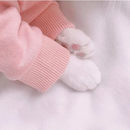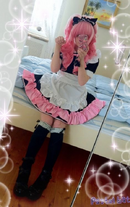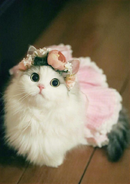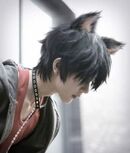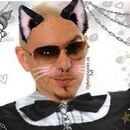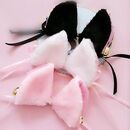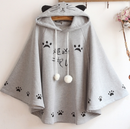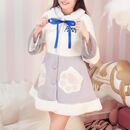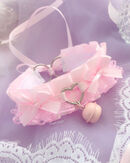Neko is an aesthetic related to the cat-people (most notably catgirls, and sometimes catboys) trope in anime and manga. Neko is the Japanese word for cat, the correct term for cat-people is technically neko-mimi. The trope may go back to 1924,[1] but the culture rose in popularity during the 2010s when the trope became a part of otaku culture (see Animecore). Since then, it has become a staple in meme and stan culture as well, where users would edit images and videos to turn the subject into a cat-person. This aesthetic is really popular among the Kawaii Gamer community. Cat-girls are a staple in Erokawaii(sexy cute). Neko is a substyle of Petcore.
This aesthetic is popular within the transfem community as their ideal post-transition selves.[2] The charm of the Neko aesthetic is its exaggerated childlike femininity. This aesthetic is mostly expressed on Twitter and TikTok and various other social medias. Including cat-ears and cat-tails has become a staple on most Picrews (a Japanese site for avatar creation).
Cat-people (aka Nekos) are generally normal humans with cat ears and a tail. However, some have other cat-like features like paws for hands or feet. They also have often have cat-like(especially kitten-like) personality traits such as being playful, cuddly, and even bratty. Other kinds of kemonomimis(animal-ears) exist, such as wolf-people, bunny-people, and fox-people, to name a few, and also take on traits associated with that animal.
Please note that cat-people may not consider themselves furries; they wear cat ears, tails, and mittens that look like paws, but not full fursuits. Cat-people also do not identify as a cat, they simply enjoy dressing up or roleplaying. Certain cat-people are furries, however, but most of them are not.
Neko and other kemonomimi styles are sometimes associated with the BDSM sub genre of Pet Play, which focuses on the power dynamic between an owner and pet(and can also sometimes be non-sexual). Kitten Play is a popular form of Pet Play which draws on cat girl tropes. Many people who wear Neko fashion are not, however, associated with Pet Play and simply enjoy the style. Because of the connection with Kitten Play, there is strong overlap between the Neko and Babygirl aesthetics, and the fashion is often very similar. A more babyish ‘kitten’ version can also exist in conjunction with Puppycore.
Visuals[]
Visuals of this aesthetic typically include cute pastels and the inclusion of cats/cat features. People or characters with bright pink blush/effects are common themes in this aesthetic.
Common motifs include:
- Bells
- Bright pastel colors sometimes mixed with black
- Cat imagery such as paws
- Cartoon catgirl patterns/drawings, sometimes with an actual cat
- Kawaii imagery
Fashion[]
Neko fashion can range from E-Girl to Kawaii Gamer to Pastel Goth to Softie. It commonly involves:
- Cat ear headbands or clips with fluff in them
- Cat tails
- Chokers/collars (often with either bell or heart ring)
- Bows and ribbons (often attached to chokers or the cat-ears)
- Small bells (often attached to chokers or the cat-ears)
- Over-sized pom-pom hoodies and sweaters
- Woolen coats
- Maid dresses
- Long fluffy gloves
- Big fluffy mittens that resemble paws
- Long stockings with cat-like patterns or shapes, or with paws on the bottom
Neko fashion often intersects with Lolita and Maidcore because of the dresses utilized.
History[]
Japanese mythology contains many cat yokai(spirits) such as Bake-Neko and Neko-Mata. The oldest mention of catgirls (with the term "nekomusume") was from a 1700s misemono where a cat/woman hybrid was depicted.[3] The first instance of catgirls in a modern sense was in a 1924 book titled "The 4th of Narcissus Month" by Kenji Miyazawa, where the first catgirls appear as beautiful women with cat ears. The next time catgirls were in media was with the DC Comics characters, Catwoman and Cheetah in 1940.
Catgirls wouldn't appear in anime until "Ousama no Shippo" in 1949. The second anime to include a catgirl was 1968's popular "GeGeGe no Kitarō." The catgirl in this anime was named Neko Musume - which likely popularized the term Neko for cat-people. Anime wouldn't see another catgirl until the start of the 1980s with a short film titled "Star of the Cottonland" by Mushi Productions. This anime tells the story of a kitten named Chibi-Neko, who was adopted by a 18 year old Boy named Tokio, and dreams of being a human (but still with their cat ears).[4] In 1988, the Puma sisters (android catgirls) from "Dominion Tank Police" were introduced to the public. And 1989 had "Ranma 1/2", where characters that are normally human but can transform into catgirls were introduced. Overall, the 1980s paved way for the catgirl trope to rise in popularity.
The 1990s did not have any notable catgirls until Natsuki Sasahara made her debut in "Hyper Police" in 1997. Natsuki Sasahara is the closest representation to the modern view of catgirls. "Outlaw Star" featured the next influential catgirl in 1998 - Aisha Clanclan - who got to be in space. In 2002, "Tokyo Mew Mew" was the first magical girl anime that had a main character transform into a catgirl as their ideal magical form. Finally, in 2008, the creation of Blair from "Soul Eater" was a catgirl who could reverse transform herself from a cat into a human with cat ears. Since then there hasn't been any new innovations within the Neko trope, except for catboys.[1]
Media[]
Anime Movies/Shows[]
- Asobi Ni Iku Yo! (2010)
- Cat Planet Cuties (2010-2012)
- Etomata Mayoi Neko Overrun (2010)
- GeGeGe no Kitarō (1968-2020)
- Hyper Police (1997)
- KiraKira☆Pretty Cure A La Mode (2017-2018)
- Magical Meow Meow Taruto (2001)
- RWBY (2013-2018)
- Ranma 1/2 (1989-1992)
- Star of the Cottonland (1984)
- Tokyo Mew Mew (2002-2003)
- Wolf Children (2012)
Subgenres[]
Catboys/Male Neko[]
Catboys are men that are half-cat (thus having cat ears, a cat tail, and paws). Catboys are almost always feminized, wearing traditionally feminine clothes or edited to have feminine characteristics. However, catboys can sometimes wear more masculine clothing - it depends on the media, the character, and the person. Although catboys tend to be portrayed as femboys, this is not true of other kemonomimi boys such as puppyboys or foxboys who are typically portrayed as masculine.
Resources[]
External links to help get a better understanding of this aesthetic.
Pinterest Boards[]
- Neko anime by Sakura💞🌸
- • Catboys/catgirls icons • by sanii uwu
- 【Catboys & Catgirls】 by Neekolight
- ♡ Nekos ❪Anime, Manga❫ by Flávia - cнαท
- catgirls n boys by mira ♡









